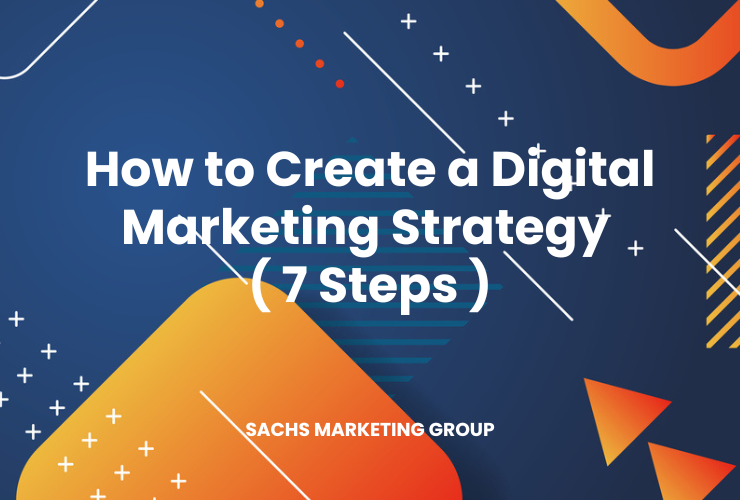Creating a digital marketing strategy involves identifying your audience, defining your objectives, evaluating competitors, and determining your marketing channels. You should also outline your content strategy, set up reporting tools to track performance, and delegate responsibilities to your team. Each step should align with your business goals for maximum effectiveness.

Are you struggling to gain visibility in the digital world? The complexity of online marketing can seem overwhelming and quickly become discouraging if you don’t have a plan.
This is where a well-crafted digital marketing strategy comes in. With a clear digital marketing strategy, you can turn your pain of low online presence into a pleasure of high engagement and conversion rates.
In this article, we’re sharing 7 steps that will teach you how to create a digital marketing strategy for your business.
What is a Digital Marketing Strategy?
A digital marketing strategy is a comprehensive plan that outlines how a business will achieve its marketing goals through online channels like search, social media, email, and content marketing.
It serves as a road map, guiding your marketing activities towards reaching its business objectives. This strategy encompasses various components including the following:
- Audience identification
- Goal setting
- Competitive analysis
- Channel selection
- Content creation
- Performance tracking
How to Create a Digital Marketing Strategy
In the modern, internet-driven world, having a digital marketing strategy is no longer a luxury, but a necessity. Businesses of all sizes, across various industries, are leveraging the power of digital marketing to reach out to their target audience, promote their products and services, and ultimately drive growth and profitability.
However, digital marketing is not just about throwing content into the online world and hoping it sticks. It’s about crafting a thoughtful, comprehensive plan that considers your audience, goals, competition, and the unique attributes of each digital channel. It’s about aligning this plan with your overall business objectives and adjusting your tactics based on performance data. This process, while possibly challenging, is crucial for any business aiming to thrive in the digital landscape.
Embarking on the journey to create your digital marketing strategy may seem overwhelming. But with a structured approach and by breaking it down into manageable steps, it becomes significantly simpler. This article is here to guide you through those steps, offering advice and insights to help you craft a robust and effective digital marketing strategy. So, let’s dive in and explore the world of digital marketing strategy creation!
Keep reading to learn how to create a digital marketing strategy in seven steps.
Step 1. Identify Your Audience
The first step in creating a digital marketing strategy is identifying and understanding your audience. This involves defining the characteristics of the people most likely to be interested in your product or service. You can collect demographic data such as age, gender, location, and income, but it’s also important to understand your audience’s habits, interests, and problems that need to be solved.
For example, a local bakery may target busy working parents in their community, who value convenience and are looking for quick, easy, and delicious meal solutions. On the other hand, a tech startup offering a fitness-tracking app might target health-conscious millennials who are tech-savvy, follow fitness influencers on social media, and prefer to exercise outside the gym.
Remember, the key to effective marketing is knowing your customer. You can create detailed buyer personas to better visualize your audience and tailor your digital marketing efforts to their specific needs and preferences.
Step 2. Define Your Goals and Objectives
The next step is to clearly define what you want to achieve with your digital marketing strategy. It’s crucial to set SMART goals – Specific, Measurable, Achievable, Relevant, and Time-bound. Your goals should align with your overall business objectives.
For example, an e-commerce clothing store may have the goal of increasing website traffic by 50% in the next six months through SEO and content marketing. A local restaurant, meanwhile, might aim to boost online reservations by 20% in the next quarter through targeted social media ads.
Remember, each business is unique, and so are its goals. Defining your objectives upfront ensures your digital marketing efforts have a clear direction and allows you to measure success.
Step 3. Evaluate Your Competitors
A thorough competitor analysis allows you to understand your industry landscape, identify key trends, and recognize opportunities to differentiate your business. Look at how your competitors position themselves, their pricing, their marketing strategies, and the customer experiences they provide.
For example, if you’re a SaaS business offering project management tools, you might find that your competitors are focusing heavily on paid search ads, have extensive content marketing strategies, and offer 24/7 customer support. Use this knowledge to find gaps in their strategies and capitalize on them.
Step 4. Determine Your Digital Marketing Channels
The digital marketing channels you choose to use should depend on your audience and your goals. These could include search engine optimization (SEO), pay-per-click advertising (PPC), email marketing, social media marketing, content marketing, and more.
For example, a B2B software company might focus on LinkedIn for social media marketing, leverage SEO to drive organic traffic, and use email marketing for nurturing leads. A B2C e-commerce brand, meanwhile, might invest heavily in Instagram and Facebook ads, PPC ads for immediate visibility, and email marketing for customer retention.
Each channel offers different advantages and requires a unique approach. By understanding each one and how it can benefit your business, you can create a multi-channel digital marketing strategy that optimizes your reach and impact.
Step 5. Outline Your Content Strategy
Content is the lifeblood of your digital marketing strategy. It drives traffic, builds brand awareness, educates customers, nurtures leads, and converts prospects into buyers. Your content strategy should define the types of content you will create, the topics you’ll cover, the platforms you’ll use, and how often you’ll publish.
For example, a health and wellness blog might create a mix of informational articles on nutrition and exercise, how-to guides, personal success stories, and video workouts. These could be shared on their website, social media platforms, and email newsletters. The content should always provide value to the audience, addressing their needs, answering their questions, and helping them achieve their goals.
On the other hand, a B2B technology company might focus on creating in-depth white papers, case studies, webinars, and blog posts on industry trends and best practices. They could leverage LinkedIn for sharing their content and nurturing business leads.
Step 6. Set Up Your Reporting Tools
Once your digital marketing strategy is in place, you’ll need to track its performance. This is where reporting tools come in. They allow you to measure the success of your campaigns, analyze the behavior of your audience, and gain insights to optimize your strategy.
Google Analytics is a powerful tool for tracking website and campaign performance. It can show you where your traffic is coming from, what content is most popular, and how users are interacting with your site. Email marketing platforms often include analytics for tracking open rates, click-through rates, and conversions. Social media platforms provide insights into post engagement, audience demographics, and more.
Regardless of the tools you choose, the key is to focus on the metrics that align with your goals. This could be website traffic, lead generation, conversion rates, customer acquisition costs, or others.
Step 7. Delegate Responsibilities to Your Team
Effective digital marketing requires a range of skills, including content creation, SEO, data analysis, social media management, and more. It’s important to delegate responsibilities to your team based on their strengths and expertise.
For example, you might have one team member responsible for content creation, another for SEO and analytics, and another for managing social media channels. If you’re a small business owner wearing multiple hats, consider the benefits of outsourcing digital marketing tasks to a digital marketing agency.
Remember, clear communication and collaboration are crucial for a successful digital marketing strategy. Regular check-ins and updates can ensure everyone is aligned and working towards the same goals.
Need Help Creating a Digital Marketing Strategy?
In the vast digital marketplace, standing out can feel like an insurmountable challenge. But it doesn’t have to be that way.
As a full-service digital marketing agency, Sachs Marketing Group specializes in creating robust, tailored digital marketing strategies that reach your target audience and yield real results. Our expertise spans across search engine optimization (SEO), social media marketing, and pay-per-click advertising, ensuring a comprehensive approach.
Imagine achieving your business objectives faster and more efficiently than ever before, while also building a stronger relationship with your audience. We’ve done it for others and we can do it for you.
Contact Sachs Marketing Group today to discover how we can help create a powerful digital marketing strategy that propels your business forward. Your success story starts here.
Frequently Asked Questions
We hear a lot of questions relating to creating a digital marketing strategy, so we thought we’d share a few of the most frequently asked questions here along with some answers.
How can I create a simple digital marketing strategy?
To create a simple digital marketing strategy, start by identifying your target audience and understanding their needs. Define clear, measurable goals that align with your business objectives. Select the appropriate digital channels to reach your audience such as social media, email, SEO, or PPC. Create valuable, engaging content and use analytics to monitor performance and adjust as needed.
What should a digital strategy contain?
A digital strategy should contain a clear definition of your target audience, goals and objectives, a competitive analysis, and a selection of the most effective digital marketing channels for your business. It should also include a content strategy outlining what type of content will be shared and on which platforms, analytics tools for tracking performance, and an action plan delegating responsibilities within your team.
What is a successful digital marketing strategy?
A successful digital marketing strategy effectively identifies and reaches a target audience, engages them with relevant, high-quality content, and drives desired actions, such as sales, sign-ups, or shares. It’s measurable, adaptable, and aligned with the overall business goals. Success often involves high return on investment, increased brand awareness, strong customer relationships, and improved market share.
What is an example of a digital marketing strategy?
An example of a digital marketing strategy could be a small business using local SEO to attract nearby customers, regular blog posts to provide valuable content, and social media to engage with their community. Their measurable goals could include increasing website traffic by 20% over 6 months and gaining 200 new social media followers. They would use analytics tools to track their progress and make necessary adjustments.
Conclusion
Creating a digital marketing strategy might seem daunting, but it’s essentially about knowing your audience, defining your goals, understanding your industry, and choosing the right tactics to reach your audience and achieve your objectives.
With careful planning, regular monitoring, and ongoing optimization, you can create a digital marketing strategy that drives growth and success for your business.
If you need help, contact Sachs Marketing Group to discuss how our team can create a digital marketing strategy that takes your business to the next level.


